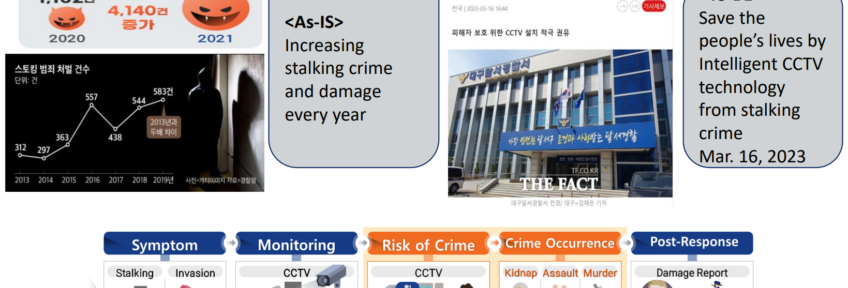With the aim to help potential victims recognize and avoid danger before falling victim to stalking crimes, the KISA and the NPA collaborated to develop a relevant technology. It is technology capable of detecting precursors of stalking crimes. It provides warning to potential victims and alert the police, aiding in the apprehension of the offender before any harm is done. By adopting this technology to over 1,200 high-risk stalking victims, Korea has successfully safeguarded from stalking crime
Innovation Summary
Innovation Overview
Sexual violence, domestic violence, and stalking crimes are serious social issues that contribute to a continual rise in the annual number of individuals seeking protective measures for “personal safety” from the police. Although protective measures for personal safety are actions taken to prevent potential crimes. However, as the crime rate among protected individuals has increased more than threefold from an average of 7% over the past three years(2018 to 2020) to 21% in 2023, doubts about the effectiveness of the current “personal safety” measures have been raised. 88% of the individuals under protective measures are either female or the socially vulnerable class in need of social protection. However, instances of individuals under protective measures being exposed to the danger of serious crimes such as assault and murder have recently seen a significant increase. Under the existing system, the apprehension of the suspect is done after a crime is committed, making it an ex post facto response taken after significant, irreversible damage is caused to the victim. Consequently, there has been a call for a victim-centered approach to detect early signs of crime and prevent crime.
The Ministry of Science and ICT proposed collaboration with the NPA to enhance preventive measures by the video analysis capabilities of
Smart CCTV. This collaboration aims to help victims recognize early signs of crimes, such as loitering, illegal intrusion attempts, and lurking, which could cause secondary harm, enabling victims to avoid potential dangers. KISA is an institution that developed the world’s second Smart CCTV performance verification technology and is responsible for conducting relevant testing and certification. Each year, KISA has continued to enhance the Smart CCTV technology for disaster prevention and crime prevention.
Innovation Description
What Makes Your Project Innovative?
The stalking crime prevention technology powered by Smart CCTVs has the following innovative aspects.
- By integrating the AI technology into surveillance cameras, which were previously available only for post-crime apprehension of the offender(s), it has become possible to identify signs of stalking crimes in advance and inform the victims, thereby preventing any harm.
- Through the collaboration with the NPA, the technology capable of detecting precursors of stalking crimes based on real cases of stalking crime has been developed and upgraded, boasting the outstanding performance in the relevant field.
- As the innovative technology and solution have been implemented in the fields and sites where the effects can be directly felt by citizens, there is strong support for this innovation among citizens.
What is the current status of your innovation?
The phases of the innovation:
- The development of the technology capable of detecting precursors of stalking crime was completed in October, 2022. Detectable Precursors: illegal intrusion, damage to entry points, snooping, and acts of dating violence
- The Smart CCTVs have been installed and are operational for high-risk victims of stalking crimes. In 2023, a total of 1,200 high-risk stalking victims were provided with Smart CCTV installations, which prevented numerous serious stalking crimes, including murder, assault and kidnapping.
- As the excellent effects were confirmed in 2023, in 2024, a greater number of high-risk stalking victims are expected to be protected with the Smart CCTVs. Also, through continuous enhancement of the AI performance, a more sophisticated technology will be developed.
Innovation Development
Collaborations & Partnerships
- KISA: Development & Provision of AI Training Data, Technology Development/Support for Performance Enhancement, Verification of Smart CCTV Performance
- MSIT: Policy Recommendation, Solution Development and Task Coordination & Implementation
- NPA: Operation of the Protective Measures for Crime Victims, On-site Response & Situation Assessment
- Private Enterprises: Software Development, Installation of Smart CCTV Devices for Individuals Protected via Protective Measures for Personal Safety
Users, Stakeholders & Beneficiaries
- Protecting the socially vulnerable: 88% of those under protective measures for “personal safety” are female. (Individuals with a high risk to be targeted for stalking (1,200 individuals) have been protected.)
- Preventing stalking crimes in advance: Crime cases are averted through preemptively detecting precursors of crime
Innovation Reflections
Results, Outcomes & Impacts
- Stalking crimes have been prevented by installing Smart CCTV systems around the homes of individuals under protective measures (about 1,200 individuals)
- Who benefit from this innovation, and how? Protecting the socially vulnerable by preventing felonies that could harm stalking victims
- 88% of those under protective measures for “personal safety” are female. Individuals with a high risk to be targeted for stalking (1,200 individuals) have been protected.
- Crime cases are averted through preemptively detecting precursors of crime
Challenges and Failures
The technology to analyze video footage taken from super-short-ranges had not been widely used. Therefore, there was the need for extensive real-world training data to enhance the performance of the technology in the private sector. However, due to issues such as compliance with the Personal Information Protection Act, the use of real-world video data was not possible. To resolve this issue, KISA, the NPA, and 18 local police agencies joined forces to develop 1,300 probable scenarios and construct the real-world video database.
Conditions for Success
Even after successfully developing the technology and enhancing its performance, it was crucial to ensure its performance in real-world settings, not just in the lab environment. To this end, typical residence types for stalking victims (multi-unit housing, apartments, etc.) were identified, and the solution ready for immediate implementation was developed through on-site demonstrations. The on-site demonstrations contributed to improving the performance, identifying and resolving real-world issues.
Replication
This innovative technology can be applied and utilized in any country and environment. The caveat is that the data required to train the AI technology varies depending on the spatial elements (wide hallways, backyard, etc.) and environmental factors (fog, rain, snow, etc.). This challenge can be met by developing and demonstrating diverse training data. Recently, street assaults, dating violence, and stalking have emerged as serious issues. KISA hopes this technology will be widely adopted globally, thereby preventing harm and protecting many people.
Lessons Learned
The public sector in the Republic of Korea has installed and operates around 1.65 million CCTV cameras. According to statistics, each person in South Korea is exposed to about 18 different CCTV cameras per day. By integrating AI into the extensive public infrastructure, we aim to develop technology aimed at preventing various accidents or crimes.
Anything Else?
- To develop and enhance this technology, training data for AI were complied and developed. Working with the NPA and 18 local police agencies, KISA extracted 1,300 real cases of stalking crimes and built the training dataset amounting to 1.83 million cases, which were used to develop and enhance the solution for detecting precursors of stalking crimes. Around 1 million cases of training data are needed to develop a new AI-driven video analysis service.
- Owing to the data building, the technology’s performance has been improved, showing the performance enhancement rate of 23%.
- Performance score prior to KISA’s data support: 72.9 → Performance score after KISA’s data support: 90.2
Project Pitch
Status:
- Implementation - making the innovation happen
- Evaluation - understanding whether the innovative initiative has delivered what was needed
Date Published:
14 February 2025


